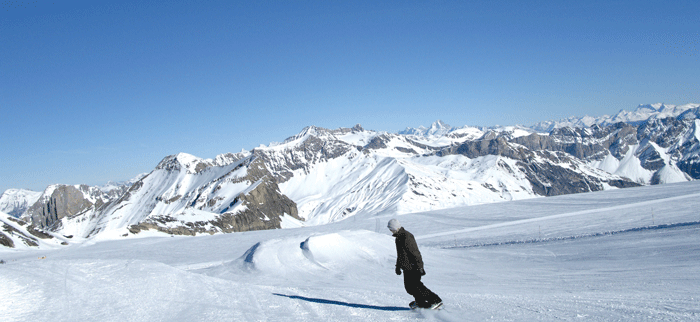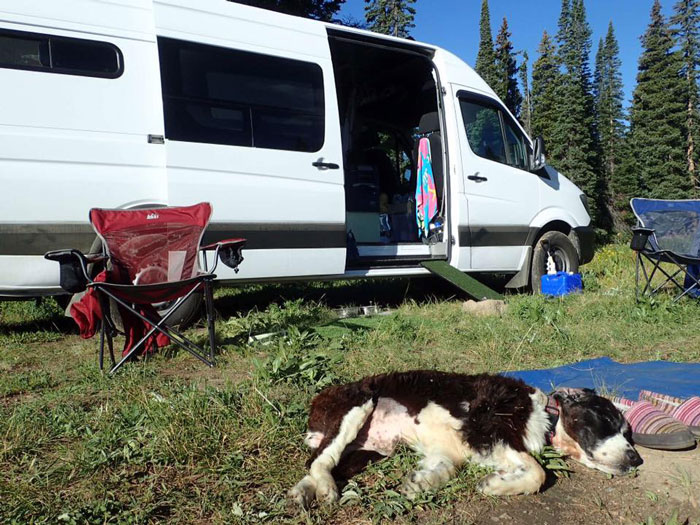- Tahoe’s Nevada Beach Tops the List of Hard-to-Book Campgrounds - 07/17/2024
- Cannabis Watershed Protection Program Cleans Up Illegal Grow Sites - 07/10/2024
- French Fire - 07/05/2024
Snowskating Approaches Critical Mass
By Melissa Duge Spiers
Go ahead, you can admit it. You miss the days when snowboarding made you feel like a rebel on the slopes. You enjoyed it when people nearly fell off the lift watching you carve down the hill below them on that weird new board-thingie. And you definitely miss the young fans following you on and off the slopes; peppering you with questions about that crazy thing you’re riding.
With all the shredders, tele-masters and tricksters at the resorts today it is nearly impossible to distinguish yourself from any of the other baggy-pantsed downhillers. Unless you’re the next Flying Rutabaga, you are sorta …well…run of the mill. But all is not lost: hold onto your boards because you are going back to the future and will be showered with questions and attention again this season. You are freeing your toes, bro: you’re a snowskater!
Snowskating has been around since the 1970s, but it suffered for many decades under the general notion that those strange skateboard/ski hybrids were “just toys.” A growing community of snowskaters has recently been upending the myths that long limited the sport to just an underground hobby, however, and the resurgence of interest in the sport has earned it broad acceptance at resorts. Disproving its freak-fad reputation, snowskating has gained an ardent global following with its own manufacturers, blogs, Facebook fan sites, and competitions.
As with snowboarding in the 1980s, the sport has spread primarily by word-of-mouth. Once you see it, you just have to try it. But indeed, what is it? It’s simply skateboarding on the snow (or skiing on a skateboard) completely unfettered by bindings.
We are so thoroughly conditioned to think we must be firmly shackled to our downhill equipment that most people refuse to believe you can truly ride the entire mountain without bindings. “How do you stay on that thing?” is a constant, skeptical refrain, but the answer is pretty darned simple. You stay on your snowskate just like a skateboarder does: with a combination of grip tape, gravity, and grace.
The freedom from heavy boots, bindings, and boards is wonderfully liberating. You will never again be one of the masses in the lift line dragging a heavy board at an unnatural angle behind you.
But no matter how much they envy your freedom, most people still won’t believe your sleek new ride is actually useful. A typical response is the disbelieving question, “Can you actually ride that thing? Like…uh…down the hill?” Yes, anyone from your 3-year-old daughter to your father-in-law can snowskate. It is no more difficult than riding a snowboard: all you need is a snowskate and a leash. Given the right skate, snowskaters can ride any terrain as well as a skier or snowboarder.
Modern snowskates are divided into two simple categories: single-deck and bi-deck. Single-deck snowskates resemble small snowboards with grooves on the bottom and waterproof grip tape on top. They are most often used for riding in parks and urban terrain. Experienced riders can take them downhill, but they generally lack the all-mountain maneuverability of a bi-deck snowskate and are often banned at ski resorts.
A bi-deck snowskate is what the first timer will undoubtedly be riding down the mountain. A bi-deck snowskate consists of a skateboard deck mounted on a small ski or snowboard with light, metal trucks. The responsive combo of deck and ski delivers excellent control and unprecedented versatility. Bi-deck snowskates can be tailored to different riding styles and conditions: larger and longer for big-mountain or powder conditions, and smaller/shorter for tricks and stunts. The trucks on most bi-deck snowskates also allow for the bottom board or ski to be interchanged with those of other sizes and shapes in order to maintain nearly endless options with minimum effort and investment.
Snowskaters across the US and Europe have been steadily proving their all-mountain versatility in powder and back country riding as well as in a growing number of park and downhill tournaments. Devoted groups have sprouted up in nearly every snow-worthy US state, and around the world including Austria, Norway, France, and Japan. These days, snowskaters are now welcomed at almost all resorts in the Sierra. The Tahoe area holds some of the longest-running, most respected snowskate competitions, ranging from the classic Ralston Cup to the quirky invitation-only Bonser Pipeline, and is the home of several snowskate companies (see sidebar).
As an enthusiastic member of this burgeoning, über-hip community, you can now answer all the standard questions about the sport with great expertise. And you can proudly tick off the bonus benefits of snowskating for your legions of new slopeside fans: All of your gear fits into an average-sized duffel bag. You wear normal shoes. You happily embrace traverses. When you get on and off the lift you just ride—no foot dragging, no stopping to buckle or unbuckle. When you wreck, you just tumble off your skate (your leash makes sure it stays close but doesn’t compound your fall). And of course you answer that most frequent question of all with just a hint of superiority: “What is that thing?”
“It’s a snowskate, dude.”
————————————————————————————————————————————————————————
Snowskate Resources
Most resorts in the Sierra and the surrounding area allow snowskating. For a complete list check the resorts tab at the Predog Snowskate website. Tahoe area tournaments include the Ralston Cup at Sierra-at-Tahoe, the Minus 7 Melee at Donner Ski Ranch, and the Bonser Pipeline (by invitation). Guaranteed awesome parties, competitions are also a perfect place to meet other riders and see the newest gear from local snowskate makers.
Project Snowskate is a helpful blog by Reno-based women’s snowskate champ Kendra Wilson.
Newborn Snowskate Magazine is a good place to start for general information about snowskating.
Most bi-deck snowskates are purchased online. Predog, Ralston, Pioneer, and Fuse are four companies that sell skates and all the gear on their websites.
——————————————————————————————————————————————————————————
Melissa Duge Spiers divides her time between Tahoe Donner and Santa Cruz. She is the proud den-mom of the Predog Snowskate crew, step-mother of two snowskate champions, and a beginning snowskater herself. In the off-season she runs marathons and is working on her first novel.


















